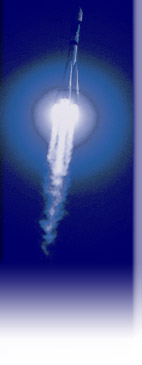Soyuz rolls out to the launch pad for its December 27 liftoff with COROT
December 26, 2006
The upgraded Soyuz 2-1b version of Starsem's workhorse launcher is ready for tomorrow's mission with the European COROT astronomy satellite, which will be performed from Baikonur Cosmodrome in Kazakhstan.
 |
The Soyuz vehicle has been erected on launch
pad no. 6 at Baikonur Cosmodrome. |
|
Rollout of the Soyuz from its final integration facility occurred on Sunday, December 24, followed by its erection on launch pad no. 6 at the Cosmodrome.
This flight is being conducted under the joint responsibility of Starsem and its Arianespace affiliate, with the liftoff set for 8:23 p.m. local time on December 27 (14h23 GMT, 5:23 p.m. in Moscow, and 3:23 p.m. in Paris).
The upgraded Soyuz 2-1b features improved navigation accuracy, enhanced control capability and a more powerful third stage engine. It represents the latest step in a cooperative European/Russian program to evolve the Soyuz launcher - which subsequently is to be introduced by Arianespace in commercial operations from the Spaceport in French Guiana.
With Soyuz' future service start-up at the Spaceport, it will become the reference medium-class launch vehicle for governmental and commercial missions, joining the heavy-lift Ariane 5 and lightweight Vega.
The COROT payload for tomorrow's Soyuz flight was developed by the French CNES national space agency in an international scientific effort that involves France, Austria, Spain, Germany, Brazil and the European Space Agency.
COROT was produced by Alcatel Alenia Space, and the 605-kg. satellite is designed to study the vibratory performance of stars to determine their internal structure, age and composition. Data from the spacecraft also will be used to seek out new planets, possibly confirming the existence of telluric celestial bodies with physical properties comparable to the Solar System's own rocky planets.
COROT will be placed in a circular orbit inclined at 90° to the equator, at an altitude of 900 km. This will enable it to continuously observe the same area of the sky for 150 days without its view being obstructed by the Earth or the Sun.
The satellite is to be released by the Soyuz' Fregat upper stage approximately 50 minutes after liftoff. Fregat is a re-ignitable propulsion system, and it will make two burns prior to deploying the COROT payload.







